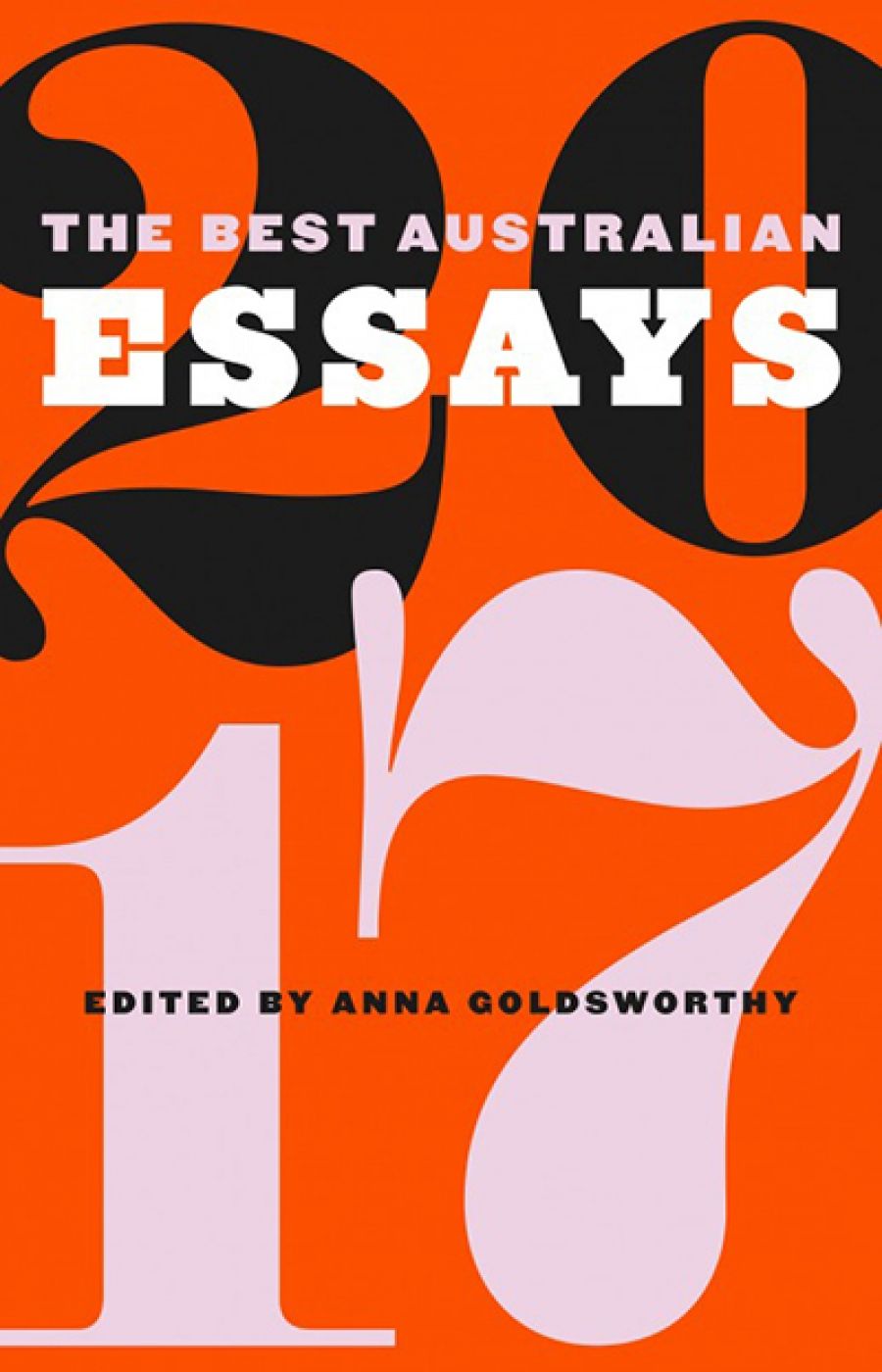
- Free Article: No
- Contents Category: Anthologies
- Custom Article Title: Lucas Thompson reviews 'The Best Australian Essays 2017' edited by Anna Goldsworthy
- Review Article: Yes
- Online Only: No
- Custom Highlight Text:
It takes only five months for a newt to regrow a lost limb. Skittles and Tic Tacs both made public statements denouncing Donald Trump during the 2016 Presidential race. Psychologists have learned that whenever we believe that a problem – like addiction, domestic abuse, or climate change – is intractable, our brains appear ...
- Book 1 Title: The Best Australian Essays 2017
- Book 1 Biblio: Black Inc., $29.95 pb, 318 pp, 9781863959605
Mandy Sayer’s moving piece on daily life in a public housing complex in eastern Sydney fits squarely in the category of those essays that offer new insights and perspectives, as does Robert Skinner’s essay on camel trekking in the Flinders Ranges. Janine Mikosza gives us an intimate portrait of a friend’s childhood trauma and her subsequent struggle to find the language to express it, and in ‘Hello Stranger’ Sonya Hartnett shows us the precarious lives of rescue dogs. Also in this category is Tim Flannery’s fascinating essay on Australian avifauna, which relays several recent discoveries on their evolution, including the theory that songbirds may have taught humans how to sing by shaping our sense of melody and pitch. Meanwhile, Keane Shum gives us a harrowing account of the plight of the stateless Rohingya, asking us to look more closely at their suffering and attempts to seek refuge in Australia, as well as their tragic status as ‘citizen[s] of nowhere’. The best of these pieces serve as accessible introductions to particular fields of knowledge or enquiry. They invite us to do further reading or thinking on a given topic.
Other essays model the processes by which we ascribe meaning to disparate elements of lived experience. These pieces, some of the collection’s most compelling, show how emotions, thoughts, and experiences can be connected in ways that only reveal themselves after careful thought and effort. When Michael Adams, for instance, strives to find connections between freediving, his father’s suicide, imposter syndrome, and international travel, we look on in awe as he wrestles the raw data of experience into a coherent form. His essay, ‘Salt Blood’ (winner of the 2017 Calibre Essay Prize), oscillates between vastly different narratives and kinds of knowledge, and shows how we ourselves might acquire similar forms of meaning from looking closely at our own experiences, interests, and intuitions. Amanda C. Niehaus writes another perfect example of this kind of associative essay, linking breast cancer, a PhD on tadpoles, and the birth of her first child in a dream-like, experiential web. Likewise, Anwen Crawford’s reflections on Prince, Bob Dylan’s Nobel Prize, Lady Gaga, and the poetics of pop music perform a similar magic trick. Her piece is a razor-sharp account of why we are drawn to musicians, and why we mourn their absence so intensely.
There aren’t as many overtly political essays as in previous collections, though Goldsworthy has made sound choices in this category. Remarkably, Richard Cooke’s dispatch from the final months of the Trump campaign, more than a year after its original publication, still makes for essential reading. This is partly because he is able to cut through the clichés and journalistic shorthand used to characterise Trump’s base. (‘There is a simultaneous impulse to patronise, excuse, exonerate, mansplain, coddle, and make fun of the attendees,’ Cooke admits at one point, but admirably resists the urge to indulge in such practices himself.) Other politically urgent essays include Stan Grant’s poignant reflections on the Makarrata Declaration and Micheline Lee’s personal account of navigating the National Disability Insurance Scheme. Nick Feik also offers a brilliant piece on the evils of Facebook, which, like Cooke’s piece, explores some of the terrifying forces that are reshaping contemporary politics.
There are only a handful of odd inclusions here, which stand out in an otherwise strong collection. Barry Humphries’ dull and humourless article on Australian slang hardly deserves inclusion, nor do several other pieces that end up forgetting about the reader and veering off into self-indulgent territory of one kind or another. Michael Mohammed Ahmad’s curmudgeonly piece on teaching creative writing in western Sydney contains some level-headed advice for would-be writers, but ultimately it’s too long and too unkind.
 Anna Goldsworthy, editor of The Best Australian Essays 2017 (Black Inc.)
Anna Goldsworthy, editor of The Best Australian Essays 2017 (Black Inc.)
Some of this space might instead have been given to younger and lesser-known writers, who aren’t represented strongly enough here. Nor is there enough representation from the breadth of Australian literary publications. Seven of the collection’s twenty-eight essays were originally published in The Monthly (including Helen Garner’s powerful essay ‘Why She Broke’), while many of our most interesting publications go missing. Unusually for this series, there is also not a single essay that first appeared in a major Australian newspaper.
Nevertheless, this is a lively and rewarding collection. Goldsworthy is right to say in her introduction that the very fact of ‘these voices – stylish, vital, frequently wise – is a source of hope’. Let’s hope for another year of high-quality local writing, which – like the best of these pieces – can transfigure intense personal experiences, scraps of fact, and the turbulence of our troubled times into art.


Comments powered by CComment